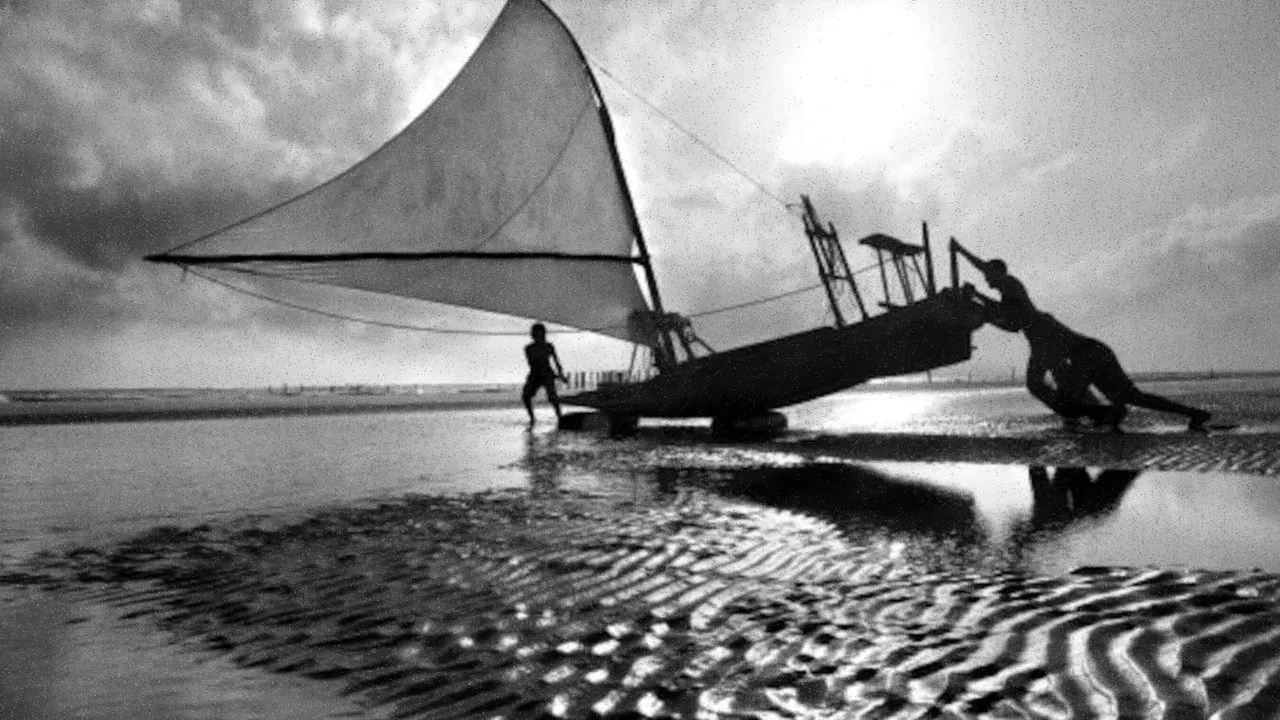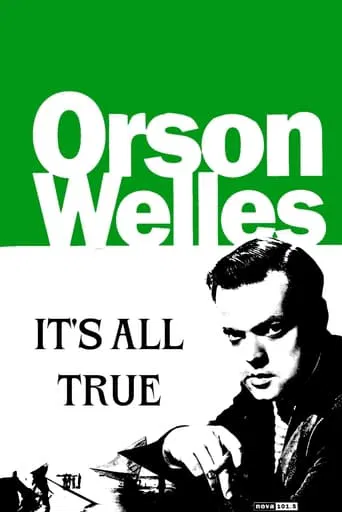

That was an excellent one.
... View MoreSERIOUSLY. This is what the crap Hollywood still puts out?
... View MoreInstead, you get a movie that's enjoyable enough, but leaves you feeling like it could have been much, much more.
... View MoreBlistering performances.
... View MoreAfter years of reading about this aborted film of Orson Welles, I finally got to see It's All True on Netflix disc. We see interviews with him explaining how the new regime at RKO had not only reedited The Magnificent Ambersons without his input while he was in Brazil, but also how eventually they cancelled this one while he was there. There was supposed to be a story of a boy and his donkey, a carnival sequence, and one of four men on a raft going on a journey. There are only snippets of the first two but a more complete version of the last one which is silent with a musical score that sounds very modern. This was a fascinating find and I highly recommend It's All True for any Welles buffs out there.
... View MoreIt is by sheer luck sometimes that an artist's work survives. For centuries the works of the Greek dramatist Menander did not exist except for occasional quotes (including "whom the Gods love die young"). But since 1905 one complete play, one nearly complete play, and five huge fragments exist to be studied by drama students. They were found on various papyri that managed to survive in the dry climate of Egypt.With Orson Welles there are several films which are seriously missing scenes he shot that were cut. THE MAGNIFICENT AMBERSONS is the best known (cut and a new ending attached), but there is also THE STRANGER, THE LADY FROM SHANGHAI, CONFIDENTIAL REPORT, MACBETH, and IT'S ALL TRUE to ponder. Welles had a way of making enemies due to his ego, but he was a brilliant film maker, and to see the damage these pygmies did to his work makes one angry. The fate of Konrad Meinike in THE STRANGER was to be the culmination of half an hour of activity in the film showing his escape from prison in Europe and his traveling to Latin America to locate the man he worked with - who would kill him. The famous crazy house sequence in THE LADY FROM SHANGHAI is only a small segment now of what Welles shot (that segment is still great, but the missing footage probably was superb). Restoration on CONFIDENTIAL REPORT makes it coherent now, and MACBETH now has it's original length and soundtrack. TOUCH OF EVIL too has been somewhat repaired based on the memos Welles left of his intentions for the film.IT'S ALL TRUE, unlike the other films, was never completed enough in any form to be shown to the public. Welles went to Latin America, having finished shooting AMBERSONS, and was to do a "good neighbor policy" documentary for the Roosevelt administration under the auspices of Nelson Rockefeller. He had to also cut AMBERSONS, and his finished cut version was butchered by his enemies at RKO who had it's end re-shot. Political differences with the Brazilian strongman, Getulio Vargas, helped doom IT'S ALL TRUE, and caused the footage to be left on a shelf to rot rather than to be released.Over the years film historians noted it's existence, until finally in 1990 or so some began preserving and editing the best surviving footage. Unfortunately much of the sections on "MY FRIEND BONITO" and of "The STORY OF SAMBA" was lost, but enough lasts to show Welles' eye for film was working brilliantly. Fortunately the last section, "FOUR MEN ON A RAFT" survived, and could be put into coherent form. It told the story of four poor fishermen from the north - east corner of the country with grievances, who sailed a raft (with one or two stops) all the way to Rio, in order to see President Vargas. They managed to do it. But Vargas did not really help these fisherman (one of whom was killed apparently when Welles was filming the sequence). The sequence is not only moving, but also extremely beautiful to look at. One gets the impression that Welles' Latin American documentary would have been a gorgeous one.The version of IT'S ALL TRUE is the closest we will ever have to what Welles meant to show. I recommend watching it, with the commentary sequences showing Welles at work, and his explaining the way things went wrong. Enjoy what is left. It is worth seeing.
... View MoreThe history behind Orson Welles' planned third feature, after his debut (which we all know the name of) and during his troubled post-production on Magnificent Ambersons and role in Journey into Fear, is as fascinating and miraculous as the footage still salvaged. Welles was sent down to make a "good-will" doc on a carnival in Rio. When he got there, he was over-whelmed with the "humanity" of the people, and got pieces of footage whenever he was awake during the time of the carnival. He also filmed footage on a sound-stage (one of his few times to work with color) of the people in their celebration. But as he focused a crucial part of his documentary on a story he read on Time, about four impoverished, immensely courageous fishermen wanting to see their government and sailing hundreds of miles over two months on a raft to do so, the plug was pulled on the film. Apparently the studio, which switched hands (hence, the Ambersons situation), didn't like what Welles' was showing them, which was a bunch of dailies without the essential musical element. So, Welles, not fazed by the rumors that he was partying the whole time with the Brazilian brethren, did what any creative genius would do- he went from being a wunderkind in Hollywood to a Guerilla filmmaker along the high seas.It's All True, the original title of the scrapped-by-the-studios project, is put into two parts, and while it resonates with the kind of movie-doc exposition of Lost in La Mancha in the first part, the second part is simply put, Wellesian. Richard Wilson (once Welles' assistant), Bill Krohn, and Myron Meisel, gather up interviews with the real locals from the time, or relatives, and put together a sort of video history on the tale of the Jangadeiros, and Welles's impact on the people (many of whom never saw a movie before). First, there are wonderful, if all-too-brief, clips of an unfinished part of the documentary called "My Friend Bonito". Then, we get to see an inside look at how the (un-true) rumors of Welles' debauchery that supposedly ruined the project, ironically, forced Welles' to cut corners to get his vision done - which becomes more intense after the original leader of the fishermen, Jacare, dies in a drowning accident. There are interesting interviews as well with Welles and his collaborators. Some of this is rather adulatory, but it's also enthralling as a trip into a time capsule, and into a director's process (i.e. using an extremely limited budget to finish the film).And the second part of the film is, aside from the part on the film's checkered history, is a unique example of history itself. "Four Men on a Raft", Welles' silent-film dramatization of the events as detailed in the Time article, is for me one of the greatest silent films never seen. Like in Citizen Kane, he uses some of his trademarks, like inventive low-angles and deep focus, but as well he implements such a heavy documentary style (some have said it's "Eisenstein-like", which I can see since it concerns a story of the working people against the fascist-types), it's no less than one of Welles' most daring feats as a director. Although this version has no audible dialog (people talk, no voices), and unlike many other silent-films there are no inter-titles explaining what they say. On top of that, there is a musical score provided by Jorge Arrigada that is rousing and pretty appropriate for the tones and sections of the film, but is arguably not what Welles' might have used. What is extraordinary about this kind of dramatized (and I say dramatized because there is an added love story in the mix, not based on truth) film is that it's the precursor to neo-realism that barely saw the light of day. It's amazing that by himself, Welles' managed to form together his own sort of storytelling style in what remains of his film, that is very simplistic and completely with non-actors, and makes it work as a remarkable piece of art. The camera just watches things happen, and how it watches is all the more special in how Welles, with his cinematographer George Fanto, uses as much expressionism as naturalism in the compositions. Bottom line, this one part of the film is as courageous as the people who inspired it, and as a piece of film history, It's All True successfully provides insight and enjoyment. After all, what better way to showcase Orson's passion for life and film with a Samba!
... View MoreI loved this examination of Welles' South American misadventures, because it challenged and successfully overturned my prejudices towards Welles; namely, that in his early years he squandered much of his talent and potential while becoming Hollywood's "bad boy," partying in the streets of Rio on RKO's tab until they had no choice but to pull the plug on his project. Instead, the filmmakers paint a much more sincere portrait of Welles as a committed filmmaker and artist, with circumstances beyond his control ultimately destroying not just his hard work, but the hopes of an entire oppressed underclass.Amazingly, the filmmakers were able to locate the survivors (and their relatives) to piece together, first the chronology of Welles' stay in Brazil, and eventually the raw footage itself, to give us at least a glimpse of what Welles had planned to release. It's also a fascinating look at the early documentary tradition pioneered by Robert Flaherty and John Grierson (though ultimately I think the evidence suggests Welles may have been more influenced by Eisensteinian agit-prop).For anyone interested in a sympathetic portrayal of American cinema's most praised and controversial director, I highly recommend IT'S ALL TRUE.
... View More